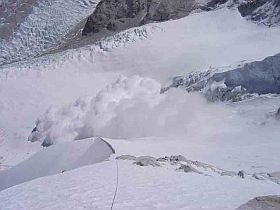|
|
Avalanche Facts
We compiled several avalanche facts, encountered in reading literature on the subject matter. Some of the figures and statistics can be intuitively figured out, and some may come as a little surprise. As the logic dictates it’s best not to be caught up in an avalanche to start off with, but given the laws of chance, all you can do is stack figures in your favour.

Our List of Avalanche Facts.
- Up to 89% of victims involved in avalanches are men.I am thinking it must be our testosterone which not only takes us beyond the boundry, but also beyond the edge.
- Common age of avalanche victims is 20 –29 years of age.
- Up to 75% of victims are recreational explorers, whom step beyond the boundary.
- Backcountry skiers and cross country skiers are at greatest risk of being involved in an avalanche.
- The incidence of fatalities increases as more individuals embrace the mountain-way-of –life. This includes urbanization of the mountain side, greater exploration of mountainous terrain, and generally greater participation in mountain sports.
- Another one of avalanche facts are, the highest fatilities in the Northern hemisphere occur in Jan,Feb,March period.In the Southern hemisphere on the other hand July,Aug,Sept.
- Worldwide annual casualties from avalanches are estimated around 150.
- Most avalanche deaths result from suffocation. It is not the tubling action which is likely to kill you, but lack of oxygen when trapped under the snow.
- Avalache risk is at its greatest 24 hrs following a snow fall.
- Fresh snow fall which has not bonded well to the underlying snow poses a serious avalanche danger. This is the classical recipe for a slab avalanche.
- Freshsnow cover exceeding more than 25cm or 12 inches poses a greater avalanche risk than snowfall cover less than 25cm.
- Variable day and night temperatures, ranging from freezing to thawing are good at destabilizing the snow pack.
- Mountain snow overhang ought to be treated with caution. This snow formation occurs when a gust of wind blows snow to the other side of the mountain peak, leading to snow clumping into a pinnacle-mass.The entire mountain side becomes avalanche prone territory.
- The Northern hemisphere receives wind storms travelling from West to East, so in highest probability (without knowing much else about the region, or it’s conditions) the eastern side on the mountain is at greater avalanche risk.
- Avalanches are more common on steeper 30-40deg slopes.
- Slopes under a cast shadow, have a colder snow pack. These slopes are not undergoing as much melting-refreezing, hence the fresh snow pack layers are not bonding with new snow layers, and such may pose a greater avalanche risk.
- Traversing steep valleys poses an avalanche risk.
- Forested regions are safer avalanche spots, provided they don’t lie under hazardous avalanche peaks.
- Cracks and whooping sounds are good warnings of a pending avalanche.
- Another of avalanche facts: beacons do save lives in the avalanche country.
Studies show activation of a beacon when traversing avalanche terrain, yields
Better outcomes than waiting for an avalanche to cover you before you activate it.
Once burried under snow, this is your only portal with the outside world.
If I find new avalache facts as they come to light I will let you know.
From avalanche facts back to home page.
|
|





